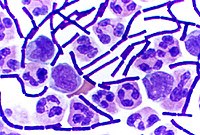
Structural insights into the mechanism of a novel protein targeting pathway in Gram‐negative bacteria
Sign Up to like & getrecommendations! Published in 2020 at "FEBS Open Bio"
DOI: 10.1002/2211-5463.12813
Abstract: Many nascent polypeptides synthesized in the cytoplasm are translocated across membranes via a specific ‘translocon’ composed of protein complexes. Recently, a novel targeting pathway for the outer membrane β‐barrel proteins (OMPs) in Gram‐negative bacteria was… read more here.
Keywords: protein; mechanism; gram negative; negative bacteria ... See more keywords

Bacterial Outer Membrane‐Coated Mesoporous Silica Nanoparticles for Targeted Delivery of Antibiotic Rifampicin against Gram‐Negative Bacterial Infection In Vivo
Sign Up to like & getrecommendations! Published in 2021 at "Advanced Functional Materials"
DOI: 10.1002/adfm.202103442
Abstract: The efficacy of conventional antibiotics therapeutics has declined rapidly due to the emerged antibiotic resistance. There is an urgent need to develop novel approaches to address the problem of antibiotic shortage, particularly for Gram‐negative bacteria.… read more here.
Keywords: msn omv; rifampicin; outer membrane; gram ... See more keywords

Exploration of the structure–activity relationship and druggability of novel oxazolidinone‐based compounds as Gram‐negative antibacterial agents
Sign Up to like & getrecommendations! Published in 2019 at "Archiv der Pharmazie"
DOI: 10.1002/ardp.201900129
Abstract: To gain further knowledge of the structure–activity relationship and druggability of novel oxazolidinone‐based UDP‐3‐O‐acyl‐N‐acetylglucosamine deacetylase (LpxC) inhibitors as Gram‐negative antibacterial agents, compounds containing the hydrophobic tails with different lengths and terminal substitutions were synthesized and… read more here.
Keywords: gram negative; structure activity; novel oxazolidinone; oxazolidinone based ... See more keywords

How bacterial cell division might cheat turgor pressure – a unified mechanism of septal division in Gram‐positive and Gram‐negative bacteria
Sign Up to like & getrecommendations! Published in 2017 at "BioEssays"
DOI: 10.1002/bies.201700045
Abstract: An important question for bacterial cell division is how the invaginating septum can overcome the turgor force generated by the high osmolarity of the cytoplasm. I suggest that it may not need to. Several studies… read more here.
Keywords: gram positive; gram; gram negative; division ... See more keywords

Motuporamine Derivatives as Antimicrobial Agents and Antibiotic Enhancers against Resistant Gram‐Negative Bacteria
Sign Up to like & getrecommendations! Published in 2017 at "Chembiochem"
DOI: 10.1002/cbic.201600532
Abstract: Dihydromotuporamine C and its derivatives were evaluated for their in vitro antimicrobial activities and antibiotic enhancement properties against Gram‐negative bacteria and clinical isolates. The mechanism of action of one of these derivatives, MOTU‐N44, was investigated against… read more here.
Keywords: motuporamine derivatives; agents antibiotic; antimicrobial agents; gram negative ... See more keywords

Combined use of lipopolysaccharide-binding protein dsRNA and Gram-negative bacteria for pest management of Coptotermes formosanus.
Sign Up to like & getrecommendations! Published in 2023 at "Pest management science"
DOI: 10.1002/ps.7405
Abstract: BACKGROUND RNA interference (RNAi) technology is an environmentally friendly strategy for controlling insect pests. Lipopolysaccharide-binding protein (LBP) recognizes lipopolysaccharides, which are a major outer membrane constituent of Gram-negative bacteria. We propose that the LBP gene… read more here.
Keywords: binding protein; lipopolysaccharide binding; management; negative bacteria ... See more keywords

Reconstruction of the Gram-Negative Bacterial Outer-Membrane Bilayer.
Sign Up to like & getrecommendations! Published in 2022 at "Small"
DOI: 10.1002/smll.202200007
Abstract: The outer membrane (OM) of gram-negative bacteria is highly asymmetric. The outer leaflet comprises lipopolysaccharides (LPS) and the inner leaflet phospholipids. Here, it is shown that the outer membrane lipid bilayer (OMLB) of Escherichia coli… read more here.
Keywords: gram negative; bilayer; outer membrane;

Bacteriological Assessment of Pneumonia Caused by Gram-Negative Bacteria in Patients Hospitalized in Intensive Care Unit.
Sign Up to like & getrecommendations! Published in 2017 at "Advances in experimental medicine and biology"
DOI: 10.1007/5584_2016_163
Abstract: The article presents the results of 11-year study (2005-2015) of Gram-negative bacteria responsible for pneumonia in 2033 mechanically ventilated patients hospitalized in Intensive Care Unit. Of 8796 biological samples, consisting mainly of bronchial aspirate (97.9 %),… read more here.
Keywords: gram negative; intensive care; negative bacteria; patients hospitalized ... See more keywords

Capillary Electrophoresis Chips for Fingerprinting Endotoxin Chemotypes and Subclasses.
Sign Up to like & getrecommendations! Published in 2017 at "Methods in molecular biology"
DOI: 10.1007/978-1-4939-6958-6_15
Abstract: Endotoxins (lipopolysaccharides, LPS; lipooligosaccharides, LOS) are components of the envelope of Gram-negative bacteria. These molecules, responsible for both advantageous and harmful biological activity of these microorganisms, are highly immunogenic and directly involved in numerous bacterial… read more here.
Keywords: capillary electrophoresis; chips fingerprinting; gram negative; electrophoresis ... See more keywords

Assessment of the anti-pathogenic effects of condensed tannin extracts using scanning electron microscopy.
Sign Up to like & getrecommendations! Published in 2021 at "Archives of microbiology"
DOI: 10.1007/s00203-020-02147-9
Abstract: Two different types of condensed tannins (CTs), which were extracted and purified from tilia (Tilia L.) and black locust (Robinia pseudoacacia), were studied and tested against two kinds of bacteria, including Gram-negative and Gram-positive, avian… read more here.
Keywords: gram negative; electron microscopy; scanning electron; microscopy ... See more keywords

A tridecaptin-based fluorescent probe for differential staining of Gram-negative bacteria
Sign Up to like & getrecommendations! Published in 2018 at "Analytical and Bioanalytical Chemistry"
DOI: 10.1007/s00216-018-1465-0
Abstract: The traditional Gram-staining method, which was invented more than a century ago for differentiating bacteria as Gram positive or Gram negative, is still widely practiced in microbiology. However, Gram staining suffers from several problems which… read more here.
Keywords: fluorescent probe; staining gram; probe; gram negative ... See more keywords